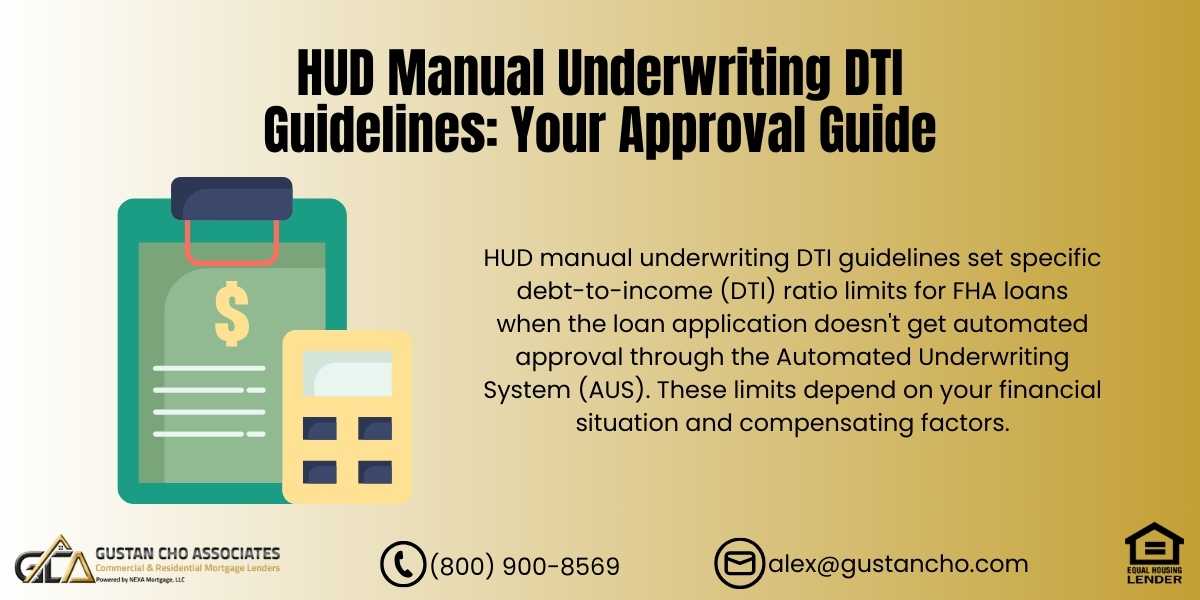HUD Manual Underwriting DTI Guidelines: Everything You Need to Know in 2024
If you’ve been denied a mortgage because your debt-to-income (DTI) ratio is too high or because of a “refer/eligible” status from the Automated Underwriting System (AUS), don’t lose hope. You may still qualify for an FHA loan through manual underwriting, which offers a second chance for borrowers who need to fit the standard mold.
This guide breaks down HUD manual underwriting DTI guidelines, how compensating factors can work in your favor, and what you need to know to secure a mortgage—even if automated systems have turned you down. At Gustan Cho Associates, we specialize in helping borrowers navigate manual underwriting, so keep reading to learn how we can help you get approved.
What Is Manual Underwriting?
Before diving into the numbers, let’s talk about manual underwriting.
Lenders often use an Automated Underwriting System (AUS) to assess borrowers’ financial profiles. AUS quickly reviews your credit, income, assets, and debts to see if you’re eligible for a loan. This step is essential to understand your financial standing and explore possible options. If you get an approve/eligible result, you’re good to go.
But what happens if AUS gives you a refer/eligible or even a refer with caution? This is where manual underwriting comes into play. A human underwriter takes the time to carefully review your file and evaluate your capacity to repay the loan rather than relying just on automation. This personal touch can give you more assurance and understanding throughout the process. Mortgage rates on manual underwriting are slightly higher. This is due to loan level pricing adjustments on manual underwriting.
Why Choose Manual Underwriting?
Manual underwriting is often used when:
- You have a high DTI ratio but strong compensating factors.
- Your credit history is limited or has issues, such as past derogatory accounts or collections.
- AUS couldn’t approve your file due to unique circumstances like non-traditional credit or gaps in employment.
The process can feel more involved, but it’s an opportunity to show that you’re a responsible borrower beyond what the numbers may suggest.
HUD Manual Underwriting DTI Guidelines for FHA Loans in 2024
When it comes to manual underwriting, HUD sets specific limits on how high your DTI ratios can be. These limits are lower than those for automated approvals because lenders see manual underwriting as riskier.
Here’s what you need to know about DTI ratios:
- Front-End Ratio: This percentage reflects how much of your gross monthly income is dedicated towards paying housing costs, including your mortgage payment, property taxes, and insurance.
- Back-End Ratio: This is the percentage of your income used to cover all monthly debts, including housing, credit cards, car loans, and other obligations.
DTI Caps Based on Compensating Factors
The number of compensating factors you have determines how high your DTI ratios can be. Compensating factors are positive financial habits or conditions that reduce the lender’s risk. Here’s a breakdown of the DTI caps based on HUD guidelines for FHA manual underwriting:
- No Compensating Factors:
- Front-End: 31%
- Back-End: 43%
- One Compensating Factor:
- Front-End: 37%
- Back-End: 47%
- Two or More Compensating Factors:
- Front-End: 40%
- Back-End: 50%
What Are Compensating Factors?
If your DTI ratios exceed the base guidelines, compensating factors can make the difference between approval and denial. Here are common compensating factors that HUD recognizes in 2024:
- Job Stability:
- A long history with your employer or steady income growth can show financial responsibility.
- Savings and Reserves:
- Having at least three months of mortgage payments saved in your bank account demonstrates financial preparedness.
- Additional Income:
- Even if it hasn’t been used as qualifying income, a second job can be a compensating factor if it’s consistent.
- Low Payment Shock:
- If your new housing payment is no more than 5% higher than your current rent, the lender’s perceived risk is reduced.
- Residual Income:
- If you have leftover income after paying all monthly expenses, it can indicate a lower risk of default.
- Larger Down Payment:
- Putting down more than the minimum (e.g., 10% instead of 3.5%) shows a commitment to the property.
How Compensating Factors Offset Risk
Manual underwriting evaluates the bigger picture. For example:
- If your back-end DTI is 50%, but you’ve been with the same employer for 10 years and have three months of reserves, an underwriter may approve you.
- On the other hand, if you lack compensating factors, you may need to work on lowering your DTI or improving other aspects of your financial profile.
Why Is Manual Underwriting Considered Riskier?
Lenders view manual underwriting as a higher risk because it relies less on automated, data-driven decisions. Instead, it depends on the judgment of the underwriter. For this reason:
- Interest rates may be slightly higher.
- Lenders may apply additional requirements, known as overlays, to further reduce their risk.
At Gustan Cho Associates, we don’t have overlays on FHA loans, making us an excellent choice for borrowers needing manual underwriting.
How to Qualify for Manual Underwriting in 2024
If you’re considering an FHA loan with manual underwriting, here’s what you need:
- Credit Score:
- You need a 580 minimum credit score to qualify for an FHA loan with a down payment of 3.5%. If your score is 500, you can still secure a loan, but you will need to provide a 10% down payment. It’s great to know there are options available!
- Debt-to-Income Ratio:
- Your DTI ratios should align with the guidelines outlined above or be supported by compensating factors.
- Documentation:
- Make sure to gather all necessary documents. You’ll need proof of income and assets. Additionally, consider writing a letter explaining any past credit challenges you may have faced. This will help present your situation more thoroughly.
Tips for Success with Manual Underwriting
- Show Stability:
- Demonstrate a stable work history and consistent income.
- Reduce Your DTI:
- Pay down debts to lower your DTI before applying.
- Save for Reserves:
- Aim to have at least three months of mortgage payments saved.
- Work with Experts:
- Choose a lender experienced in manual underwriting, like Gustan Cho Associates, to guide you through the process.
Real-Life Example: How Manual Underwriting Helped a Borrower
Meet Sarah. Her back-end DTI was 48%, which was too high for AUS approval. However, Sarah had worked for the same employer for 12 years, had six months of reserves, and was buying a home with only a 3% payment shock compared to her rent. Using manual underwriting, Sarah qualified for an FHA loan and closed on her dream home.
This is just one example of how manual underwriting and compensating factors can open doors to homeownership.
Start Your Process Towards Buying A Home
Apply Online And Get recommendations From Loan Experts
Why Choose Gustan Cho Associates?
At Gustan Cho Associates, we specialize in helping borrowers who other lenders have turned down. We understand manual underwriting and have no overlays on FHA loans, meaning we follow only HUD’s guidelines—not additional lender rules.
Here’s why borrowers choose us:
- Expertise in Manual Underwriting: Our team has decades of experience helping borrowers with unique financial situations.
- Flexible Solutions: We focus on finding creative solutions to help you get approved.
- Availability: Our loan officers are available seven days a week, including evenings and holidays, to answer your questions.
Take the Next Step
Understanding the HUD manual underwriting DTI guidelines can feel overwhelming, but you don’t have to navigate it alone. Whether AUS has turned you down or you have a high DTI ratio, Gustan Cho Associates is here to help.
Contact us today at 800-900-8569, text us for faster responses, or email us at gcho@gustancho.com. We are available 7 days a week, on weekends, and even on holidays. Let’s work together to make your dream of homeownership a reality.
Final Thoughts
Manual underwriting may seem challenging, but it’s an opportunity to showcase your financial strengths. With updated HUD manual underwriting DTI guidelines for 2024, borrowers have a clear path to approval—even if automated systems say otherwise.
At Gustan Cho Associates, we’re committed to helping you succeed. Call us today and take the first step toward your new home!
Frequently Asked Questions About HUD Manual Underwriting DTI Guidelines:
Q: What are HUD Manual Underwriting DTI Guidelines?
A: HUD manual underwriting DTI guidelines set specific debt-to-income (DTI) ratio limits for FHA loans when the loan application doesn’t get automated approval through the Automated Underwriting System (AUS). These limits depend on your financial situation and compensating factors.
Q: What Distinguishes Manual Underwriting from Automated Underwriting?
A: Manual underwriting involves a human underwriter reviewing your application. In contrast, automated underwriting relies on a computer system to assess your eligibility. Manual underwriting is often used when AUS cannot approve your loan due to high DTI or unique circumstances.
Q: What are Compensating Factors in Manual Underwriting?
A: Compensating factors are positive financial habits or situations, like having extra savings, stable income, or a low increase in housing costs. These can help you qualify for a loan even if your DTI is high.
Q: What are the Maximum DTI Ratios Allowed Under HUD Manual Underwriting Guidelines?
A: The maximum DTI ratios are:
- 31% front-end and 43% back-end with no compensating factors.
- 37% front-end and 47% back-end with one compensating factor.
- 40% front-end and 50% back-end with two or more compensating factors.
Q: What Happens if My DTI is Too High for FHA Loan Approval?
A: If your DTI is too high, manual underwriting may allow approval if you have strong compensating factors. These factors reduce the lender’s risk and improve your chances of getting approved.
Q: Why are Lenders Considering Manual Underwriting Loans Riskier?
A: Manual underwriting relies more on human judgment than data-driven automation. Because it’s more subjective, lenders may see it as riskier. They may charge slightly higher interest rates or require stricter conditions.
Q: Can I Qualify for an FHA Loan with Bad Credit Through Manual Underwriting?
A: Yes, borrowers with credit scores as low as 500 can qualify for FHA loans through manual underwriting, but you’ll need a 10% down payment. For scores of 580 or higher, the down payment drops to 3.5%.
Q: What Documents do I Need for Manual Underwriting?
A: You’ll need proof of income (like pay stubs or tax returns), bank statements, and records of assets. You may also need to write a letter explaining past credit issues, like late payments or collections.
Q: How Can I Improve My Chances of Approval Under the HUD Manual Underwriting DTI Guidelines?
A: Improve your chances by:
- Paying down debts to lower your DTI ratio.
- Saving at least three months of mortgage payments as reserves.
- Demonstrating job stability and consistent income growth.
- Working with a lender experienced in manual underwriting, like Gustan Cho Associates.
Q: Why Should I Work with Gustan Cho Associates for Manual Underwriting?
A: Gustan Cho Associates specializes in manual underwriting and doesn’t add extra lender requirements (overlays). They follow HUD’s guidelines to help borrowers with unique situations, such as high DTIs or past credit issues, get approved for FHA loans.
This blog about “HUD Manual Underwriting DTI Guidelines: Your Approval Guide” was updated on December 6th, 2024.
Take First Step Toward Making Your Dream A Reality
Apply Online And Get recommendations From Loan Experts









